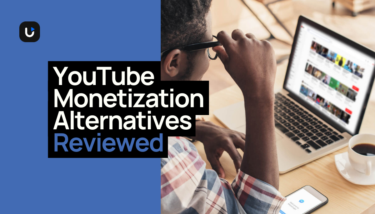Are you looking to start monetizing your videos but you’re unsure where to start? Or maybe you’re already monetizing through sponsored ads or brand deals but you’re frustrated with inconsistent revenue? Then you’re in the right place.
We’ve helped over 4,000 creators successfully monetize their video content, overcoming the same challenges you’re currently facing to gain steady, consistent revenue. Here we’re going to break down all things video monetization to help you achieve your goals; whether you’re just starting out or you’re ready to invest in your own platform – there’s something for you here.
Looking to get to grips with the basics? We’ve got you covered here
Want to start making money on YouTube? Here’s what you need to know
Ready to launch your own video membership or streaming service? Start your journey here
Excited about meeting your video monetization goals? Check out our strategies for success
How to make money with videos: your guide to getting started
If you’re just dipping your toe into video monetization and want to learn what it’s all about and the different ways of doing it, this is the section for you. Here you’ll learn what video monetization actually means, how to go about it and the different options available with real life examples.
What is video monetization?
Video monetization is simply making money from video content you’ve created and shared online. The most common way to start doing this is through YouTube Adsense where you can earn money based on the number of followers and views you have, or through a brand sponsorship where you are contracted to promote a product in your videos in exchange for payment.
Creators who have built up a strong following with a defined niche might take the next step to turn it into a business and monetize their videos by creating a video membership or streaming service where their customers pay to access their content through a recurring or one-off payment.
The different types of video monetization
There are lots of different ways to make money from videos. Let’s walk you through the different types of video monetization on offer to you, and how you can make money from each one.
Social media
Monetizing videos on social media platforms is an accessible, relatively straightforward way to make money from the content you share to your followers. YouTube is the obvious example here, but TikTok, Instagram and Facebook all have their own variety of monetization options for creators.
You can monetize video content by generating ad revenue, creating sponsored posts to promote products, offering subscriptions on YouTube or Instagram, and one off donations from followers through badges and super thanks. You can also monetize by signing up to affiliate marketing programs or selling your own products.
There’s lots of options, and many creators use a combination of these methods in their monetization strategy.
YouTube has by far been our most lucrative social media platform. Not only does AdSense pay more on long form videos than other social platforms do for video content, but brands pay a higher dollar for sponsoring long form videos largely due to their reach and evergreen lifespan.
Tips and donations
This is where you’re earning money directly from your viewers and followers who have the option of making a one off payment through tips or donations.
Twitch is a good example of this. During a live stream, viewers can make one off donations which are paid directly to the streamer. They can also show their appreciation by using the platform’s virtual currency, known as ‘bits’ to send a ‘cheer’ which pays the streamer a set fee.
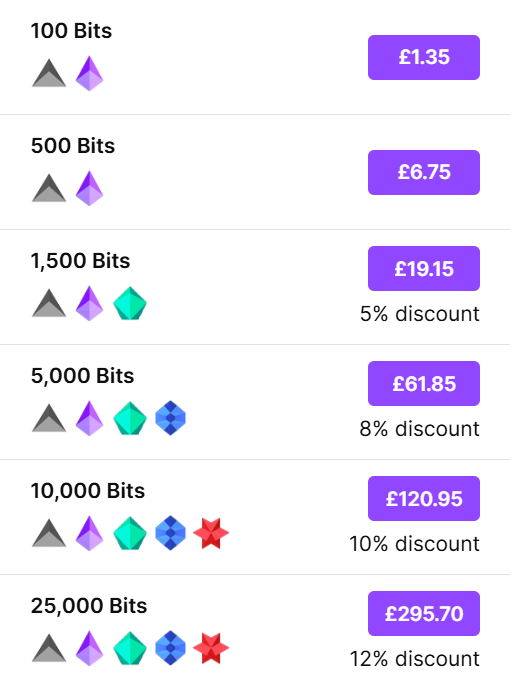
Buy me a coffee is another platform that makes it easy for your audience to make a one-off payment to support your content. For example, Tanaka San is a creator who teaches Japanese on their YouTube channel Learn Japanese with Tanaka San. Their Buy me a coffee page gives fans a way to pay them directly through small, one-off contributions that roughly equal the price of a coffee:
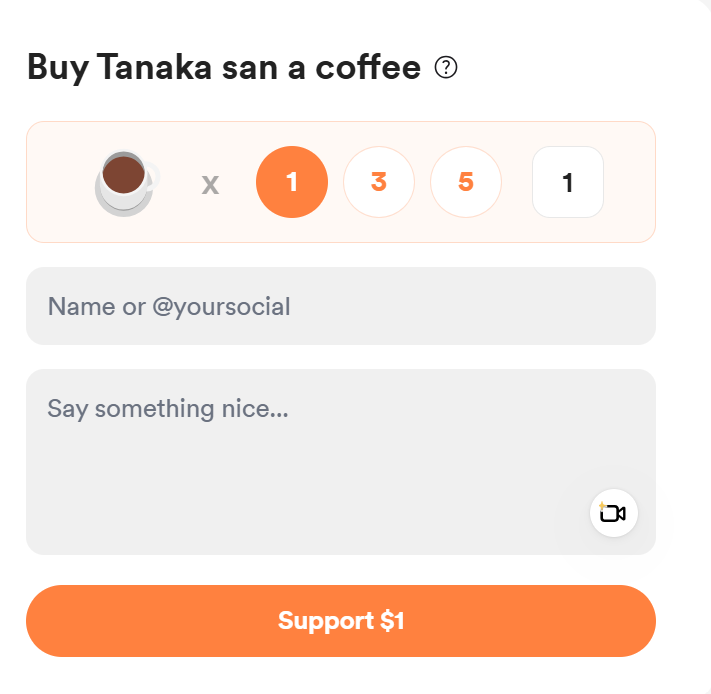
Sponsorships
Sponsorships are a popular way for creators to monetize their video content. Brands pay the creator a fee in return for creating content to promote the brand or products in their videos. It can be a lucrative option, depending on the size of your following and it can provide a reliable source of income.
Subscriptions
The subscription model works by charging a recurring fee (usually monthly) in exchange for on demand access to your video content. This option gives you ownership over your content, and the stability of recurring revenue from users who are paying you directly.
Think big streaming platforms like Netflix and Disney Plus, this model is a familiar one for today’s consumer. Some more niche examples include sites like RaceOn, which streams live footage of races in the US and Means TV, who produce their own films and TV shows directly to their audience.
Memberships
A membership combines the subscription model with a community, providing a place for users to interact with you and each other. This is ideal for creators who focus on educational content, or who want to provide a space for like-minded individuals to connect.
This works for lots of different niches, including fitness brands like Find What Feels Good, to fishing content with Your Saltwater Guide.
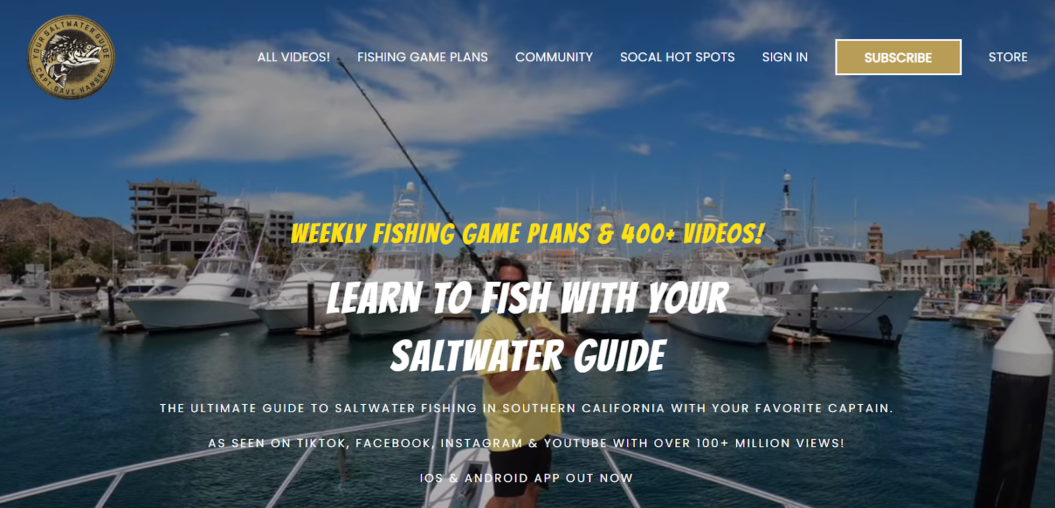
How to monetize your videos
As you can see, there’s a variety of options available for monetizing your videos. Where to begin, and which monetization methods to choose will depend on the type of content you want to create, the size of your audience and what their needs are.
Let’s start with defining your niche. This is the main topic or theme of your videos, in other words what people can expect your content to be about. There’s loads of different niches out there; everything from fitness to gaming, or learning a new skill.
Whatever it is, it should be authentically you. Something you’re passionate about, and enjoy doing. This is what makes your audience connect with you, and gain enough value or enjoyment from to keep paying for access to it.
Need some inspiration? Check out our examples of some of the successful video creators that we support here at Uscreen.
Think of it as finding your people, a niche community that you and your superstar skills and knowledge can make a difference to.
Kylie Long, our Senior Video Production Specialist here at Uscreen, shares the questions to ask yourself when you’re first starting out with video monetization to define the direction you want to go in:
- What monetization model do I want to use?
- Where do I want to monetize?
- Is my audience ready?
- How long am I willing to commit to any one experiment?
In the early stages, validate your ideas (there are a bunch of ways to do this) and then launch an MVP version of whatever video monetization system you choose. That way you avoid wasting effort on content your audience doesn’t care about, and can iterate quickly. For example, Tom Gellie of Big Picture Skiing sold a few one-off ski coaching videos, so he knew his audience was willing to pay for content. Then he launched a membership to make sure his video monetization stayed stable.
Now that you have your niche down, spend some time defining your goals. What exactly do you want to achieve from video monetization? Is it to earn some money on the side and gain recognition for your hard work? Or are you aiming to run a full time video membership business?
Being clear on what you want is an essential part of making video monetization work for you. There’s also solid evidence that writing down goals makes them much more likely to happen, because it gives you direction and a clear image in your mind to work towards and manifest.
The key is to make them specific. Follow the SMART goal format to shape your goals:
- Specific: Here, instead of saying “I want to make money from my videos”, you could turn this into something specific by saying “I want to make x amount by publishing my videos on x,y and z platforms.” Think about exactly how you want this outcome to look.
- Measureable: The question to ask yourself here is “how am I going to measure this?” you could commit to publishing a certain number of videos each week, or focus on building up your engagement on each individual video for example.
- Achieveable: For me, this one is really important because it ensures that the goal is realistic for you. For example, it would be nice to follow in the footsteps of the highest earners on YouTube, but instead, focus on what you can realistically achieve with the time, resources and audience you currently have, with room to grow over time.
- Relevant: Ensure your goal is relevant to you, and what you want to do and achieve. What works for one creator, might be totally different for what’s going to work for you.
- Time bound: Give your goal a deadline, or a set time period. This gives you an end point where you can assess whether or not you’ve achieved your goal, motivating you to get started (which, let’s face it, can often be the hardest part.)
How much you can expect to earn from video monetization
This is a big question, and there’s no straightforward answer unfortunately because this varies so much from one video creator to the next.
Like many things, it is what you make of it, and there are many factors which influence your earning potential from videos. The size of your audience is a huge factor, no matter which type of video monetization you’re going for. For brand sponsorships and paid ads, this massively impacts the amount you get paid, especially when your earnings are tied to the amount of views your video receives.
Jade Beason, creator and social media consultant, shares her insights into the earning potential of affiliate marketing:
For most creators you’re looking at under £1,000 per month, even when you have a big audience size. This is because of how much volume you need, and the amount of people who actually buy things off the back of your recommendations.”
Another factor to consider is the expectations of your niche. Are you producing videos in a popular niche where there’s plenty of demand? Or are you doing something very specific which would only appeal to a smaller niche? Either way, you want to ensure you’re giving them the experience they want and expect.
For example, Frances Long’s Your Book of Memories is an art video membership all about making beautiful memory books from scratch:
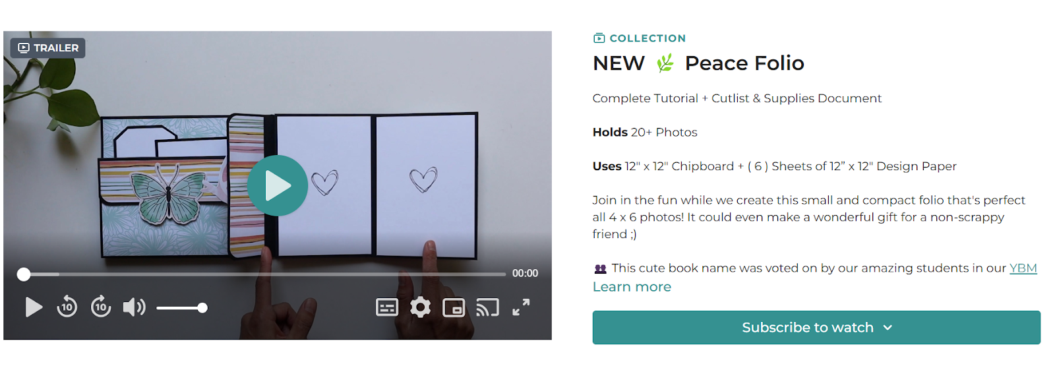
If you’re monetizing as a specific service or membership, knowing what to charge can be challenging as there’s no industry standard. Travel creators Chris and Sara share their experience:
Early on it was really hard to know/understand our worth and determine how to charge appropriately which definitely caused us to struggle with monetization early on because we were seriously undercharging. When we listened to inbound messages from brands we’d hear that we were worth about 10% of what we actually were at the time. It wasn’t until we grew our creator community that we finally started learning what our peers were charging for similar brand deals. Turns out we were worth far more than we realized. Unlike a typical career, we couldn’t just turn to Glassdoor to see what the average going rate was for a content creator. There are so many different factors that go into crafting rates (platform, niche, demographic location, etc.) which was something we really couldn’t find much info on early during our content creation careers.
Our pricing calculator tool gives you an idea of what you can expect to earn based on your individual circumstances. Try it out to give you a ballpark figure to work towards.
Use our free tool to pinpoint your ideal membership price in just 3 steps, leveraging a decade of data.
Video monetization models: how successful creators are generating revenue
AVOD, TVOD and SVOD are popular models that successful creators use to monetize their videos. There’s a lot of acronyms here, so let’s run through some quick definitions and how these monetization models work to generate recurring revenue.
AVOD
This stands for advertising video on demand. It provides free access to video content in exchange for having to watch adverts. Creators make money from the advertiser or platform based on the number of views they generate through their video.
YouTube is the best example of this, where you are served ads before and during a video (unless you’re paying for YouTube premium). You’re not paying the creator of the video to access their content, instead you’re exchanging your time and attention with the ads to be able to keep watching.
This model is best suited for creators who are starting out with YouTube monetization and are looking for a straightforward way to monetize, especially if they have other time commitments.
TVOD
TVOD is an acronym for Transactional Video on Demand. Customers pay a one off fee to access video content, and they can watch it at any time, as often as they like. This could be purchasing a film, course, or a package of videos on a particular theme.
Online courses are a good example of this. One course has a dedicated focus and purpose, so users can purchase this and work through it in their own time. They would have to keep buying if they wanted to access any other content from that same creator, but they’d have unlimited access to the content they bought.
Like these digital video sets from Pageants Live:
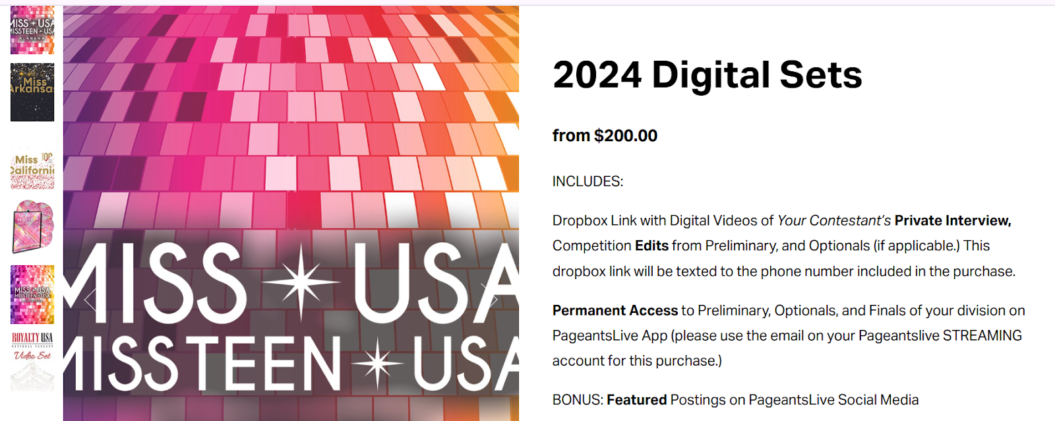
This model is best suited for creators who don’t have time to keep producing content, but want to ensure they are creating something valuable that they can market and sell to their audience time and time again.
Read more about video on demand here.
SVOD
SVOD stands for subscription video on demand. Users pay a recurring fee (usually monthly or annually) for unlimited access to your library of content. Here, the creator is earning money directly from their audience on a regular basis.
Users are paying for your own unique content that they couldn’t get elsewhere, and expect a substantial amount of high quality content that will enrich their lives.
This model is best suited for creators who already have a large library of video content, and have the time and resources to continually produce and release new videos to keep their subscribers engaged.
Memberships
The membership model builds on the idea of a subscription by adding community. Users pay to be part of a membership where they can interact with you and each other, and build up a real connection. A membership is essentially content and community in the same place.
Here’s an example from Filmmakers Academy. Members can connect with other filmmakers to build their network and share their experiences as they work through the content together:
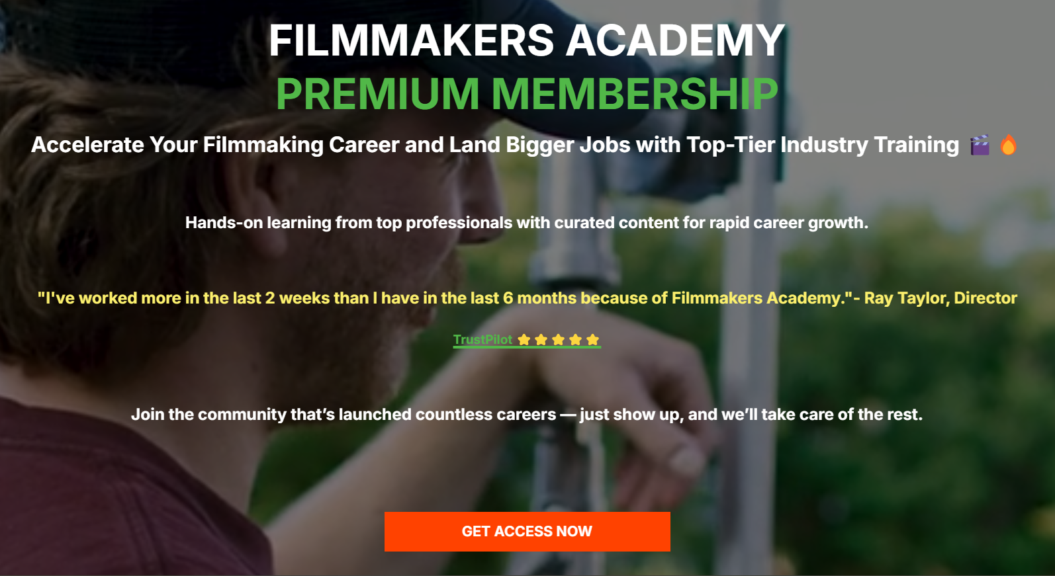
This model is best suited for creators who want to provide the maximum value from their content without having to constantly produce and build something where they can connect with their audience on a deeper level.
👉🏻Read more about these different video monetization models in depth here
Video monetization challenges (and how to overcome them)
Video monetization is not without its challenges but the real win comes from pushing through the challenges and reaping the reward from your hard work. Let’s look at three common video monetization challenges and how you can overcome them.
Challenge one: inconsistent revenue
Inconsistent revenue is a big challenge that a lot of video creators are faced with, especially when they’re starting out. This makes it difficult to scale and invest in your business when you can’t count on what’s coming in.
If we turn this into a goal: to earn a stable, reliable income from video monetization, this turns this challenge into something actionable, setting yourself up for success in the long run.
To tackle this, look at how you’re monetizing. What factors need to be present for you to earn money? Is it a bigger audience, greater reach for each individual video or more time spent on creation? Dig into the specifics and identify at least three areas that you have control over and turn these into SMART goals that you can work on in the short term.
For the long term, the answer might lie in trying out new ways of monetizing which have greater growth potential and allow you to have more control over how you reach your audience with your content.
To earn stable revenue from your video content, you need one of 2 things: a constant flow of new customers, or a set of customers who pay you consistently. The second of those two is a lot easier, which is why so many creators are building recurring businesses. Whether they call it a club, a mastermind group, a subscription, etc – they know that focusing on retention is a better route to sustainability.
Challenge two: Lack of control over monetization
This is a common challenge for creators who are monetizing on YouTube and other social media platforms. This is because these platforms are the ones in control of how you can monetize and interact with your audience. They can also change the rules at any time, which can negatively impact monetization for creators.
Brand partnerships also feed into this challenge, because it means you have to create content based on their guidelines and expectations and your earnings are subject to their terms and conditions.
Relying on brand partnerships will cause inconsistencies in your income as you often have little control over when you’ll be paid. This level of inconsistency makes financial planning very challenging.
To take control, set a goal to monetize directly from your audience. This is where the TVOD, SVOD and membership models come in.
Challenge 3: Limited capacity for one-on-one sessions
If you’re monetizing by offering live sessions with clients, then your main challenge becomes trading time for money. There’s only so many hours in the day, which limits what you can offer, and therefore what you can earn. It’s particularly frustrating when you’re passionate about what you do!
The answer? Find a way to scale your offering. A membership model could work well for you here, meeting the need to provide real value and connect one-on-one with content that’s available on demand to drive retention.
Using Uscreen has been the best monetization method I’ve used so far. Being able to offer course videos through a monthly subscription has been much more effective than trying to sell videos individually, one at a time.
How to monetize videos on YouTube
In this section we’ll talk about how to get started with video monetization on YouTube, what criteria you’ll need to meet and what the common challenges are for creators monetizing through YouTube.
If you’re ready to grow beyond your audience on YouTube, skip ahead to the next section.
What you need to get started
The first thing you’ll need to do is join the YouTube partner programme. To be eligible for this, you’ll need to have a minimum of 1,000 subscribers in addition to either 4,000 valid public watch hours in the last 12 months or 10M valid public YouTube shorts views in the last 90 days.
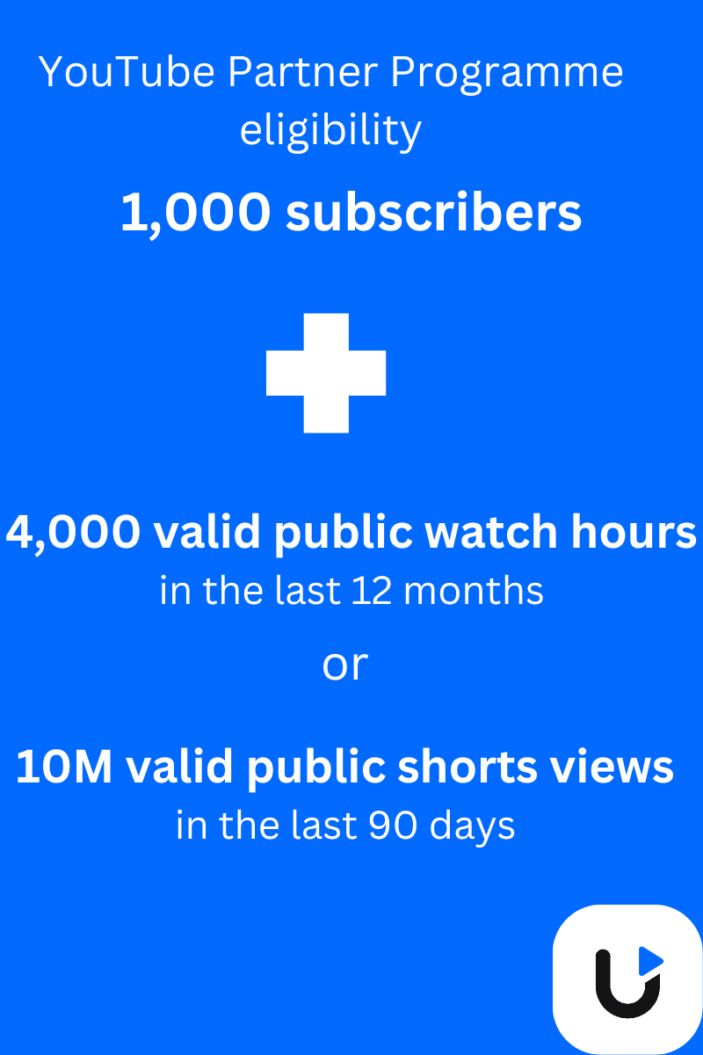
You’ll also need to meet these more general requirements:
- Follow the YouTube channel monetization policies
- Live in a region where the YouTube Partner Program is available
- Have no active Community Guidelines strikes on your channel
- Make sure 2-Step Verification is turned on for your Google Account.
- Have advanced features access on YouTube.
- Have one active AdSense for YouTube account linked to your channel (or be ready to set one up).
If you don’t meet the criteria to be accepted into the partner programme on YouTube you can still potentially monetize your videos in other ways; like affiliate marketing, brand sponsorships and selling your own merchandise. However, it’s worth noting that brands usually have their own criteria that you’d have to meet in order to be considered.
👉🏻Read more on the different ways to make money on YouTube here
Most people are pretty aware of adsense as a monetization route, but there are so many more options for monetization with YouTube. On platform you can unlock Super Chats, Stickers, & Super Thanks well before the 4,000 watch hour mark, but just relying on YouTube’s payments can be disappointing in the early stages. Having your own product is a monetization route you have so much more control over, and can launch with any subscriber number. (T-shirts are fine, but products that help your audience get closer to their goals are much much better use of your time.) You can start simple with something like a template or a downloadable, and over time use those smaller products to validate ideas for higher-ticket offers.
You can also launch an in-platform subscription on YouTube, where users pay you directly to support your channel and gain access to exclusive content. This is a relatively easy way to start monetizing directly from your audience because you can do it all within YouTube, but it has a much lower earning potential for that same reason.
For in-platform subscriptions like YouTube, your earning potential is significantly lower. You don’t want to be charging more than 1-2 dollars, because for a lot of people it’s hard to communicate the value of their subscription to their audience, especially when they’re used to seeing your content on their instagram or YouTube for free already.
YouTube monetization: common questions answered
How does advertising revenue work on YouTube?
Adsense is available for any creator in the YouTube partner programme. Once you have it set up, Google will automatically begin serving ads on your videos based on their auction system. This works by advertisers placing bids to appear in ad spaces on YouTube. The amount paid to you for the ad will depend on how much the winning bidder has agreed to pay.
Advertisers pay a set amount per 1,000 views. 45% of this revenue goes to YouTube, and the remaining 55% will be paid out to you. The Adsense website has a revenue calculator on their website where you can get an idea of how much you could earn from it, as this will vary depending on your region, content niche and the size of your following.
Your content also needs to be advertiser friendly; so no inappropriate language, violent or adult content, and stay away from controversial and sensitive issues.
YouTube has by far been our more lucrative platform. Not only does AdSense pay more on long form videos than other social platforms do for video content, but brands pay a higher dollar for sponsoring long form videos largely due to their reach and evergreen lifespan.
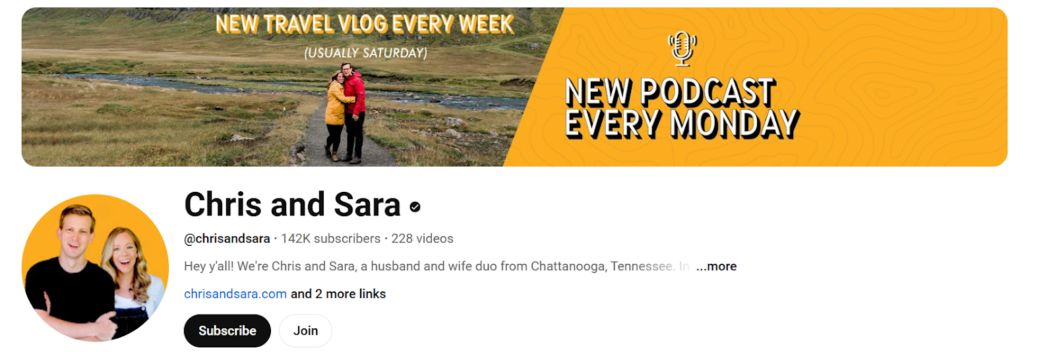
How to get started with the YouTube partner programme
If you meet the eligibility requirements outlined above, you can submit an application for the YouTube partner programme. To do this, navigate to ‘YouTube studio’ and click ‘earn’ where you’ll see the option to ‘apply now.’
Simply follow the instructions to complete your application and submit it when you’re ready. You’ll also be asked to set up your adSense account if you haven’t already.
Once you’ve submitted the application, it gets reviewed by YouTube and you can expect to hear a decision in around one month. If it’s not successful, you can appeal it within 21 days, or if it’s not your first application then you can apply again after 90 days.
How much money can you make from a YouTube video?
How much money you can make on YouTube varies widely depending on the size of your audience and how engaged they are, your content niche and the monetization methods you’re using.
At the highest end, the most successful YouTubers are earning more than $25M a year. The average estimate for creators with a following of 10,000- 100,000 is around $5,000- $15,000.
Video creator Marielou Mandl shares her insights into testing what works best for monetizing on YouTube and using it as a hub for multiple income streams:
I was monetizing on YouTube before I was getting any AdSense money because I was bold enough to pitch myself. In the early days, I found it fun to test the waters and work on my negotiation skills. Now, YouTube is the hub of many different income streams. In addition to collaborations and AdSense, the real fun is using YouTube to drive the community into my membership. I have always been willing to try the newest features and this past year, vertical livestreams have been vital to getting new eyes on what I do.
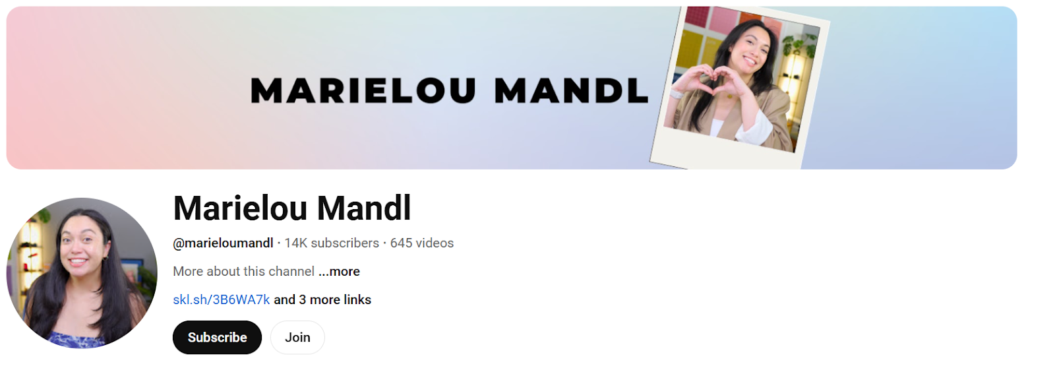
How many videos do I need to have to monetize on YouTube?
It’s not about the number of videos you have on YouTube, but the amount of watch time your content generates. You need to have a minimum of 4,000 watch hours over the last 12 months for long form videos, or 10M views of shorts in the last 90 days.
Start by analyzing the engagement your videos are getting and finding opportunities to work on increasing this. If you have a smaller following, then increasing your engagement and encouraging viewers to keep watching is going to be crucial, but this is still important even if you have a big following so you can generate enough views and demonstrate to brands that your videos are getting attention from your audience.
How long do my videos need to be to monetize them on YouTube?
There’s no minimum length for monetizing videos on YouTube. However, longer videos have greater potential to earn more revenue because you have more room to place ads or incorporate products and messaging from brand partnerships.
YouTube monetization challenges
Monetizing on YouTube does come with its challenges, so let’s look at the pros and cons:
Pros:
- It’s easy to get started, and doesn’t require an upfront investment
- You have access to a huge user base— YouTube currently has 2.9 billion users
- There are multiple ways you can monetize on YouTube
With YouTube monetization, it changes month to month based on your video performance. Sometimes it goes up, sometimes it’s down, but I don’t pay too much attention to it because it’s not a crazy amount or anything. Regardless I appreciate it and I’m glad my videos can make some money on the side just for existing. As long as you’re uploading your own original work, there shouldn’t be any monetization issues in the way.
Cons:
- Monetization can be low and inconsistent, especially at the beginning
- You’re not completely in control of your earnings on YouTube
- It’s a highly competitive space
The amount of money I earn from my YouTube channel is only partly down to me. Yes, I need to create valuable content and yes I need to share it on a regular basis and that is completely in my control but the other side is down to YouTube’s algorithm. And whilst I can optimize my videos the best I possibly can, there is a huge amount that is not within my control there which means that my income can often be very inconsistent.
Kylie Long shares her insights into how to make the most of YouTube for video monetization and the importance of having multiple income streams:
The people who are the most successful monetizing their YouTube channels are the ones who understand how the channel fits into their larger business strategy. For example, Brandon Washington’s channel is all about filmmaking gear, how to make better content, and it gives an awesome look behind the scenes of his video business. He’s set up with a couple of different monetization strategies, which is great. Multiple income streams means more security if one of them goes away. He does it all, with sponsored gear reviews, affiliate links to other tools like Canva pro, and he uses YouTube to promote his membership Creative Fam Academy.
Advice for creators at the beginning of their monetization journey
With so many video monetization options out there, how do you know what’s right for you? I spoke to a few successful creators and our internal Uscreen experts and here’s what they have to say:
My key advice to new creators is to experiment while maintaining focus. While it’s important to explore different monetization options, concentrate your efforts on one primary strategy. Promoting multiple offerings simultaneously can dilute your impact. You’ll see better returns by focusing on a single product or service, potentially linking it to complementary offerings behind the scenes. Remember to keep things simple – we often overcomplicate monetization. Above all, prioritize your community, as they’re the foundation of your success.
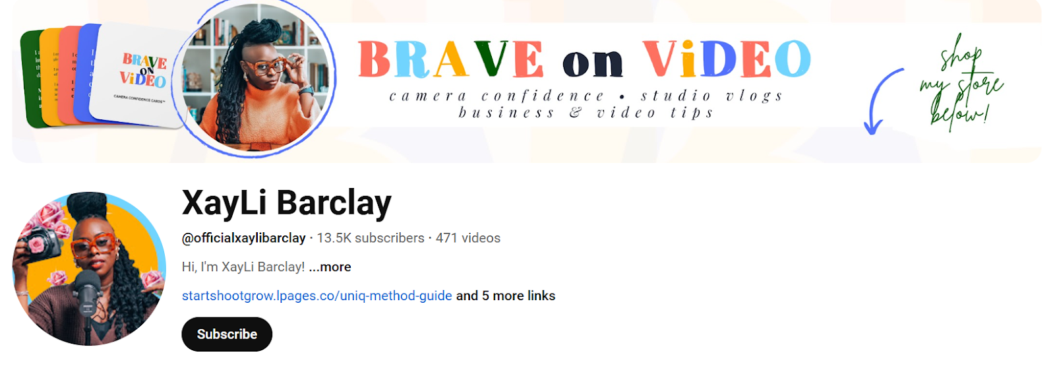
The most common question I get from creators about monetization is HOW? At a base level, people seem to be curious and often surprised that it is even possible. In the year 2025, I hope people start to believe that video monetization is a real thing, that this is a real business and an actual career path. I always want to drive home that it truly is that – a business. There are so many ways to go about it and things are always changing but it is up to the creator to make decisions, bet on themselves, and take chances in order to make it a success.
In the early stages, validate your ideas (there are a bunch of ways to do this) and then launch an MVP version of whatever video monetization system you choose. That way you avoid wasting effort on content your audience doesn’t care about, and can iterate quickly. For example, Tom Gellie of Big Picture Skiing sold a few one-off ski coaching videos, so he knew his audience was willing to pay for content. Then he launched a membership to make sure his video monetization stayed stable.
How to take the next step and monetize your content as a full time business
If you’re a creator who has already built up a substantial following and want to grow your video business in a way that gives you full control over it, then this section is for you. We’ll be looking at what to look for in a video monetization platform, our recommendations for platforms that might suit you and how to use these platforms to maximize success.
How to achieve success with a video monetization platform
What to look for in a video monetization platform
A video monetization platform is a paid for service that allows you to host video content on your own website where users can access it in exchange for a fee. It gives you complete ownership of your content, and offers lots of options for how you want to monetize and package your content.
The key features you want to be looking for include:
- Flexible monetization: look for a platform that offers multiple ways to monetize your content.
- Supports multiple currencies: make sure that the payment processor accepts a range of currencies if you’re looking to reach a global audience.
- Customer support: having the right support available to help you when needed is essential for your business. Look at reviews and testimonials from their existing customers for insights into this.
- Content ownership: ensure that you’re clear on the terms and conditions of ownership. Ideally, you want a platform where you retain the rights to your content and have full control over it.
- Pricing: carefully weigh up the costs associated with each platform, including any additional fees that would accumulate over time. Consider what’s a realistic investment based on your resources and expected revenue.
- Marketing and analytics: many video platforms have built in marketing tools to help you market your video business and gain new members, plus insights into how your sales and marketing efforts are performing. This reduces the need to manage and pay for multiple platforms.
- User experience: platforms that are intuitive and easy to use make the day-to-day easier for you, but also provide a great experience for your customers. Always think about the end result and what their experience will be like as a customer.
Next, let’s look at four popular video platforms and who they are best suited for.
Best platform for part time creators: Patreon
Patreon is a well-known platform for creators and is often the first stepping stone for many in monetizing beyond social media and YouTube. It allows fans to support you directly, and you can share your work exclusively with them.
It’s free to get started and their pricing works on a percentage system, so they take a cut of what you earn in addition to payment processing fees.
Patreon pros:
- Quick and simple to get started
- No upfront costs
- Only pay when you start earning
- Well-known brand
Patreon cons:
- Limited customization features
- Limited earning potential
- Poor end user experience (according to Trustpilot reviews)
- Lack of room for growth
👉🏻 Check out our piece on ‘Is Patreon worth it?’ for an in depth discussion on Patreon’s features, pros and cons.
Best platform for beginners: Vimeo
Vimeo is a well-known video hosting site which offers video on demand and OTT services to allow video creators to easily share and monetize their videos. It can also be used to embed videos into your own website.
It also offers video editing tools and there’s a (limited) free plan available making it accessible to get started.
Vimeo pros:
- Low barrier to entry with free and low cost plans
- Known for high quality video content
- Offers video editing tools
- Flexible video on demand monetization
Vimeo cons:
- Offers less customization features than competitors
- Lack of content organization features and room for growth
- Expensive if you want to access all the features
- Inconsistent customer support (according to user reviews)
👉🏻 Read more on Vimeo and the key alternatives to consider.
Best platform for video course creators: Kajabi
Kajabi is another established video platform which is best known for creating online courses. The platform has recently expanded to include different types of products for creators, like memberships, communities and podcasts, giving you multiple ways to monetize your video content.
There’s a lot of features available with the Kajabi platform, including marketing tools and analytics so it falls into the category of an all-in-one solution. Their plans start at $55 per month (billed annually) up to $319 per month for the pro plan, so this is best for creators who already have course content they’re ready to launch with and are ready to build and grow their business.
Kajabi pros:
- Multiple monetization options
- Built in marketing tools
- 24/7 access to customer support
- Customize the look of your products
Kajabi cons:
- Features can be overwhelming
- Advanced customization and design requires specialist support
- Limited growth potential and options for managing your content
- Mixed reviews about customer service quality
👉🏻 Read more about Kajabi in our detailed piece ‘Is Kajabi Worth it?’ where we look at the pros and cons in depth.
Best platform for established creators with a video subscription or membership business: Uscreen
Uscreen is an all-in-one membership platform built for video creators. With Uscreen, creators can easily create paid memberships that include an on-demand video library, live streaming capabilities, and their own community space, all in their own branded site and apps.
Uscreen is best for established creators who already have a substantial following and are looking to grow their business and generate recurring revenue. Pricing starts at $199 per month with additional plans to include branded mobile and TV apps.
Uscreen pros:
- Video first platform supporting a large video library
- All in one platform, including apps and community
- Easy to use and get started
- Excellent ratings for customer support
Uscreen cons:
- More expensive than the other options
- Doesn’t support other content types
- Limited learning management features for educators
Check out some examples of Uscreen customers and how they’ve found success with the platform.
👉🏻 Read more on the top rated video monetization platforms in our in depth guide.
Strategies for success with video monetization
Diversify your revenue streams
Having multiple revenue streams is a common practice among creators. This helps to balance out the instability of some of the monetization methods, giving you several avenues to generate revenue and a predictable income stream.
For example, many creators take advantage of the variety of monetization options available on YouTube, while also using the channel to promote their memberships or subscription services, which make up the bulk of their revenue.
By using this tactic, Jade Beason was able to scale her business to $15k per month in just under a year. She recommends having two primary income streams, which would be your main focus, and two secondary, which can support you in the background.
She talks about the advantage of having a video membership as a primary source of income:
Memberships are incredibly scalable. And above all else, it’s a recurring revenue stream. So you get monthly income you can rely on, give or take a certain percentage depending on what your churn rate is, which is basically the percentage of people who tend to unsubscribe or cancel their membership.
Creating digital products (like one- off courses or video bundles) are a useful addition to generate passive income, because you create them once and then all you need to do is switch on marketing automations to promote them and this can keep ticking away in the background.
Brand partnerships are another popular income stream for many creators, especially those with a large following. The benefit of having this as a secondary source of income is that you’re not fully reliant on it, so you can be choosy about the brands you want to work with, and promote products you’re truly invested in.
Whichever methods you choose, make sure you have the time and capacity to manage them all without burning out. Aim for sustainable growth, rather than racing to try and do everything at once.
Create a dedicated space for your community
An engaged community is the secret to a successful video membership. It gives your audience an exclusive online space to connect with you on a more personal level and build relationships with each other, bringing together like-minded people who otherwise wouldn’t have the opportunity to connect.
Our data finds that creators can experience a 50% increase in member retention when they offer community as part of their video membership, which is often cited as the most valuable aspect for members.
Community has helped Justin Rhodes, creator of Abundance+ to achieve success. They doubled their revenue after launching their video membership community, bringing in over $1M in annual revenue.

The reason I launched the community is because that was a classic answer to a problem I experienced, where the solution wasn’t there. How can we create a community so people are less lonely and have friends in the same space, like-minded people? So, I was meeting a need I had, realizing others had that need, and just going to town, coming up with the solution.
Get feedback on what your audience wants
Whichever niche you’re in, the most important thing is to meet the needs and expectations of your audience. Take the time to research what’s out there, what they’re looking for and what they like (or perhaps dislike) about your video content or membership.
Reaching out to your members directly to ask them for feedback benefits you in several ways:
- They can tell you directly what they want to see, and what isn’t working so well so you can improve on it.
- It gives them the opportunity to feel listened to, and create a closer connection to your membership
- It’s a proactive way of potentially minimizing member churn, as it allows you to take action to give members what they want before they reach the point of cancelling
Milou Pietersz shares her thoughts on the importance of listening to your members and using these crucial insights to keep learning and improving:
Always treat your first launch as a beta launch, and keep refining from there. I think it’s fun when members help to create the product as they opt in during the beta launch. Once you get your first members in, they will tell you what they need and what they’re looking for – helping you to refine as you go.
Wrapping things up
We’ve finally reached the end, it’s a lot of information to take in so bravo if you’re still with me 🙌
Whichever stage you’re at in your video monetization journey, there are so many options to try so don’t despair if something doesn’t work out right away. Learn from it, and keep trying, and find the right method for you.
If there’s one thing I’ve learned from my time here at Uscreen it’s that video-led businesses are going from strength to strength with the right time, attention and strategy. And, there’s plenty of room for everyone, including you. So go and create, and show us what you achieve!









